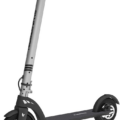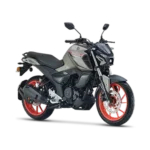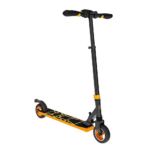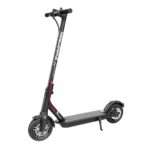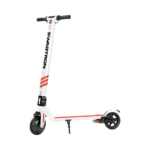- Home
- Scooters
- Electric Scooters
- Swagtron 5T
Swagtron 5T
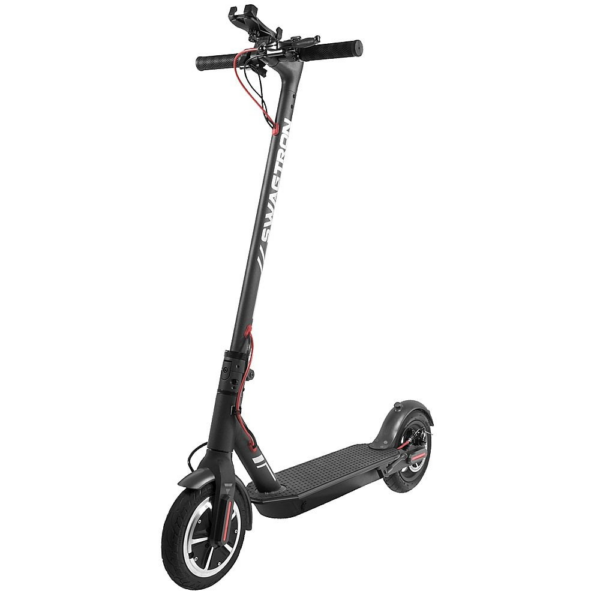

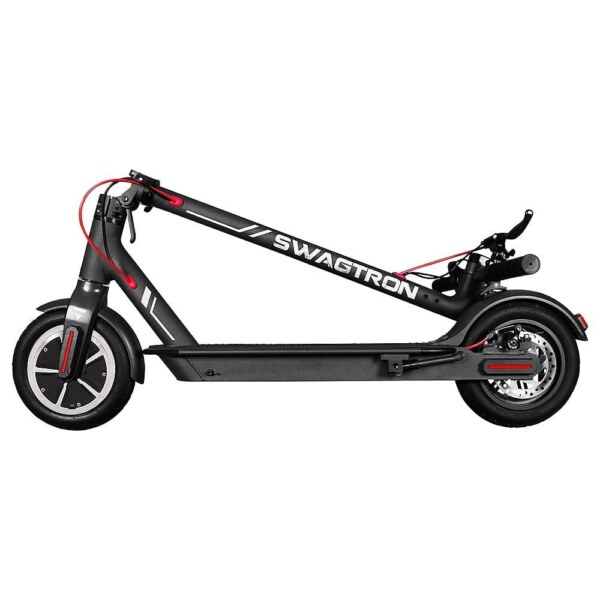

- Battery Range: 11 miles (18 km)
- Top Speed: 18 mph (29 km/h)
- Motor Power: 250 W
- Weight Capacity: 320 lb (145 kg)
- Charging Time: Not specified
- Scooter Weight: 26.0 lb (11.8 kg)
PROS
- 18 mph (29 km/h) class speed
- App support and cruise control
- Rear disc + electronic brake
- Compact fold for car trunks
- 8.5″ urban tires
CONS
- Range limited for daily commutes
- No suspension
- Battery capacity/charge time not disclosed
- IP rating not specified
Key Takeaways
- The Swagtron 5T is a compact, foldable scooter designed for short urban trips and is beginner-friendly with simple controls.
- It features a 250 W front hub motor, three speed modes, and a lithium-ion battery with a range of up to 11 miles.
- The dual braking system combines electronic front braking and a rear disc brake for controlled stops in urban traffic.
- Portability is key; at about 26 lb, it’s easy to carry and store, making it suitable for multi-modal travel.
- It’s ideal for commuters seeking a light, user-friendly ride, but not suitable for long-range or off-road use.
Table of contents
- What Is the Swagtron 5T?
- How the Swagtron 5T Works
- Key Specifications
- Design & Build Quality
- Performance Fundamentals
- Battery, Range & Efficiency
- Ride Quality & Comfort
- Braking & Safety Features
- Portability & Daily Usability
- Maintenance & Care
- Weather & Seasonal Considerations
- Swagtron 5T vs Alternatives
- Who the Swagtron 5T Is (and Isn’t) For
- Practical Tips You Can Use Today
The Swagtron 5T is a compact, foldable scooter for short city trips. It keeps things simple, light, and easy to carry. If you want a no-stress ride for first-mile and last-mile hops, it fits well. New riders will like its mild throttle and quick folding latch.
What Is the Swagtron 5T?
The Swagtron 5T sits in the Swagger 5 family, and it targets everyday travel on paved routes. You get a front hub motor for steady pull, a lithium-ion battery for short loops, and a rear disc plus electronic braking for control. So it feels straightforward on day one. Then it adds a clear display, a headlight, and three speed modes for crowded paths.
The stem folds with a quick latch, and the scooter packs flat for desks and trunks. A basic app handles ride modes and a simple lock. For many people, that checklist covers daily needs without extra fuss.
How the Swagtron 5T Works
Each part does a clear job. The front hub motor pulls you forward, which helps traction on clean pavement. The controller meters power so launches feel smooth, then it lets the motor build speed. Three modes cap the top speed when you want a calmer ride near foot traffic.
The thumb throttle sends your request to the controller. Press a little for slow rolls, or press more for quick bursts. Hold a steady pace for a few seconds, then cruise control takes over. That reduces thumb fatigue on flat, straight paths.
Braking uses two systems that blend well. The rear wheel has a mechanical disc that bites with a firm feel. The front motor provides electronic braking that starts the slowdown. So you feel a soft tug first, then a stronger stop as the disc comes in. If you want a deeper dive into brake types and what changes on the road, read this explainer on drum vs mechanical vs hydraulic disc brakes at ScooterPick. It breaks down hardware, maintenance, and feel in plain terms: Drum vs mechanical vs hydraulic disc brakes: which system should you choose?
The battery sits inside the deck. It runs at a nominal 37 volts and charges to 42 volts. Charge time lands around three and a half hours. So you can plug in after breakfast and be ready before lunch.
Key Specifications
The table below gathers the official specifications in one place. It’s easy to scan, and it shows both imperial and metric values.
| Category | Details |
|---|---|
| General | Class: foldable commuter scooter. Rider height: 4’–6’6” (120–200 cm). Max load: 320 lb (145 kg). |
| Performance & Power | Motor: 250 W front hub. Top speed: 18 mph (29 km/h). Riding modes: 3. Recommended terrain: hard surfaces, ramps under ~20°. |
| Battery, Charging & Electrical | Battery: lithium-ion, nominal 37 V, ~158.4 Wh. Charger output: 42 V, 1.5 A. Charge time: ~3.5 hours. Estimated range: up to 11 miles (17.7 km) in ideal conditions. |
| Build & Dimensions | Frame: aluminum. Tires: 8.5 in pneumatic front and rear, 28 PSI (1.9 bar). Weight: ~26 lb (11.8 kg). Unfolded: 41.5 × 17 × 45.3 in (1054 × 436 × 1150 mm). Folded: 41.5 × 17 × 19 in (1054 × 436 × 480 mm). |
| Safety & Control | Brakes: rear disc plus electronic front braking. Lights: LED headlight and rear light. Bell and kickstand included. |
| Features & Extras | Cruise control. LED display with speed and battery. Three speed modes. Bluetooth app for basic settings and a simple lock. Phone mount included on many units. |
| Warranty & Compliance | One-year limited hardware warranty in the U.S. and Canada. FCC Part 15 compliance. Operating temp: 32–109 °F (0–43 °C). Storage temp: −4–140 °F (−20–60 °C). |
Design & Build Quality
The 5T keeps the layout tidy. The aluminum stem locks with a collar and a quick latch, so folding takes a second. The deck has a grippy top layer that works with damp soles. Cables run clean along the stem and stay tucked out of the way. The front hub motor keeps the fork simple. Then the rear wheel handles most of the stopping with the disc brake, which makes service clear.
The cockpit shows speed and battery at a glance. Buttons for power, lights, and mode sit within thumb reach. The bell lives next to the lever, and the thumb throttle sits on the right. So you can keep a steady speed with small inputs. A phone mount on many units helps with ride stats, and it stays readable in daylight if you mount it low and snug.
Fit and finish match the class. Tolerances are decent, and the stem feels solid when locked. The folding hook clips the rear fender for quick carry moves on stairs. Even so, a short bolt check now and then keeps things tight. A two-minute wrench pass every few weeks helps the latch and caliper stay quiet.
Performance Fundamentals
The Swagtron 5T favors control over punch, which is right for flat urban routes. It steps off the line with a gentle pull, then it builds to mid-teens speeds without drama. The throttle curve feels friendly to new riders. Start in the lowest mode on day one, then move up as your control improves.
Cruising stability feels calm at neighborhood speeds. The wheelbase and deck height give a natural stance. Place your front foot near the stem and your back foot angled, and the scooter tracks straight with light bar input. At top speed, keep both hands steady and avoid sudden turns on rough patches. Then the chassis stays composed.
Climbs are fine on short grades in the 7–10% range. You will hold speed in the low teens on gentle hills, and you will see a gradual drop on longer climbs. So time your throttle, and add a strong kick at the base of steeper ramps. That helps the controller hold speed over the crest.
Battery, Range & Efficiency
On paper, range sits around 11 miles. Real world range changes with speed, rider weight, wind, and temperature. Cold weather trims energy, while steady mid-speed cruising helps efficiency. For a 170 lb rider on flat streets, plan for 7–10 miles, then adjust after a week of rides. Heavier riders or stop-and-go routes land lower, and warm weather at moderate speeds lands higher.
Charging is simple. Plug the 42 V charger into the deck port, then watch for the indicator to flip when full. Let the scooter rest a few minutes before you ride. That pause lets voltages settle, and it keeps performance consistent. Top off after each commute if you want the same feel day to day. You do not need to run the pack down first.
Good storage habits pay off. Keep the battery between 20% and 80% if you pause riding for more than a week. Park indoors away from direct sun. In winter, charge at room temperature, then roll out with a warm pack. Those small steps cut stress on the cells and keep output steady.
Ride Quality & Comfort
Tires set the tone here. Both are pneumatic, so you can tune pressure to match your streets. Run the factory 28 PSI for crisp steering and range. Drop a few PSI for a softer ride on cracked pavement. Check pressure weekly. Low pressure causes vague steering and raises the risk of pinch flats, so a quick check saves headaches.
The deck gives enough space for a stable stance. Keep your knees soft and your arms relaxed, then let your legs soak up small bumps. Stem flex is minimal at city speeds when the collar and latch are snug. If you feel any play, stop and tighten the hardware before you continue.
Hand feel is light and easy to learn. The throttle throw is short, which helps you hold a precise speed. Hold steady for a few seconds, then cruise control kicks in and takes strain off your thumb. Tap the brake to exit cruise right away.
Braking & Safety Features
The dual system matters in traffic, and it works as a team. The electronic brake at the front motor starts the slowdown with a smooth pull. The rear disc adds bite as you squeeze, then the scooter settles to a stop. Practice five to ten hard stops in a quiet lot. That short session makes lever feel second nature.
Lighting covers the basics. The LED headlight improves near-field visibility at dusk, and the rear light helps drivers see you. For night rides, add reflective ankle bands or a small helmet light for even better visibility. The bell is loud enough for shared paths. Use it early, and give a quick ring rather than a long one.
Water exposure is limited. The brand does not list an IP rating, and the manual warns against liquid contact. So ride around puddles when you can. If you get caught by light rain, slow down, lengthen your following distance, and dry the scooter after the ride. Avoid deep water that can splash into the deck.
Portability & Daily Usability
Portability is the point of the Swagtron 5T, and the mass stays friendly. At roughly 26 lb, one-handed carries up a flight are doable. The latch is quick, so you can fold at the curb, step on a bus, then unfold on the far side. Trunk fit is easy thanks to the flat folded height. Store it under a desk with the headlight off and the cable tucked.
Daily routines keep the scooter ready. Power on, helmet on, and roll a few inches to confirm straight tracking. Then check the tires and pull the brake lever to feel firm bite. The app is useful for mode changes and a basic lock when you step into a store. Treat that lock as a deterrent. If you need real security, add a compact U-lock through the rear wheel.
Maintenance & Care
A short schedule keeps everything tight and quiet.
- Before each ride: Check tire pressure and look for cuts. Squeeze the brake lever and confirm firm bite and smooth return.
- Weekly: Inspect the stem collar, latch bolts, and caliper bolts. Tighten to spec, then wipe dust off the deck and stem.
- Monthly: Check brake pad wear and rear rotor alignment. Spin the wheel to confirm no rub, then re-center if needed.
- Every 3 months: Balance-charge by leaving the pack on the charger for 30 extra minutes after the light flips. Then unplug and store indoors.
- Annually: Replace pads if lever travel grows long or you see glazing. Swap inner tubes if you notice frequent slow leaks.
Use a mild cleaner and a damp cloth for the frame, and keep water away from the charge port. Store the scooter between −4 and 140 °F in a dry space. If you pause riding for a month or more, leave the battery near half.
Weather & Seasonal Considerations
Rain, heat, and cold all change how the scooter behaves. Wet paint lines and metal grates turn slick, so cross them at a right angle. Braking distances grow on wet roads. Start slower, leave extra room, and brake earlier. In summer, avoid parking in direct sun, since a hot deck stresses the pack and weakens output. In winter, plan for shorter range, and keep the scooter indoors until you leave.
Wind matters as well. A headwind lowers speed and range, while a tailwind helps. So leave a small margin on the return leg. On dry, cold days, thin gloves improve lever feel. Clear lenses help on gritty, wet streets. Then you can keep both hands steady and avoid harsh steering inputs.
Swagtron 5T vs Alternatives
The Swagtron 5T shines as a light commuter. It beats bigger scooters on carry weight and folding speed, and it suits flat routes where top speed in the high teens is enough. For multi-modal travel, the low mass makes transfers painless. It also works as a backup for drivers who want to skip short car trips without wrestling a heavy frame.
Commuter models with larger batteries stretch range and hold speed on longer hills, but they add weight and cost. Performance scooters push far beyond city speeds, then they demand more runway, stronger locks, and regular wrench time. Off-road scooters add fat tires and suspension for rough ground, but they trade away trunk fit and convenience. So pick by route length, elevation, storage space, and how often you carry the scooter.
If your loop is under 6–8 miles round trip on mostly flat roads, the 5T fits well. If you climb long hills or ride 15–20 miles in a single go, a bigger pack and motor make sense. If you carry up two flights every day, the 5T’s mass feels great in hand.
Who the Swagtron 5T Is (and Isn’t) For
The Swagtron 5T is for commuters who want simple controls and low weight. Students will like the quick fold and small footprint. Last-mile riders who connect train and office will enjoy the tidy size. Multi-modal travelers will value the one-hand carry and fast setup. New riders benefit from the gentle throttle curve and three easy modes.
It is not built for long-range touring, heavy off-road, or steep neighborhoods. It is not aimed at riders who want suspension travel for broken paths. It is also not a match for speed fans who want mid-20s mph cruising. If you need those things, step up to a larger class with a higher-capacity pack and stronger controller.
Parents sometimes ask about very young riders. In that case, you want a product built for small kids, low speeds, and short decks. For a true starter toy with training-wheel vibes, see this entry for Hover-1 My First e-Scooter, which describes a gentle, kid-friendly option with capped speed and simple controls: Hover-1 My First e-Scooter
In short, match the tool to the job. The Swagtron 5T handles short urban trips with calm manners, low weight, and simple care. Set clear expectations, ride within its limits, and it will serve you well.
Practical Tips You Can Use Today
- Range planning: Start with a conservative loop and watch the battery under load. Then add distance once you see how your streets and weather affect the pack.
- Braking practice: Do five to ten controlled stops from a steady speed in a quiet lot. Feel how electronic and mechanical braking hand off.
- Tire care: Keep a small pump at home, and store a spare tube for the rear. A two-minute pressure check beats a pinch flat every time.
- Fastener routine: A quick wrench pass prevents play in the stem and caliper. That habit keeps handling tight and quiet.
Specifications
General
| Model The Model specifies the exact version or name of the scooter. It helps identify its unique design, features, and specifications within the manufacturer’s product line. Knowing the model makes it easier to compare options, find compatible accessories, or look up support information. | 5T |
| Brand The Brand identifies the manufacturer or company that designs and produces the scooter. A trusted brand is a sign of quality, reliability, and good customer support. Well-known brands often have higher standards for safety, performance, and after-sales service, giving you more confidence in your purchase. | Swagtron |
| Release Date The Release Date indicates when the scooter model was officially launched on the market. This helps you know how current the design, technology, and features are. A newer release date often means updated components, improved performance, and the latest safety or smart features. | 18 November 2025 |
| Recommended Age Recommended Age indicates the minimum age range that the scooter is designed for, based on safety, size, and ease of use. Following the recommended age helps ensure that riders can handle the scooter’s speed, weight, and controls comfortably and safely. Always check local laws and use protective gear, especially for younger riders. | +16 |
Performance & Power
| Motor Power (Wattage) What it means: The motor power, measured in watts (W), shows how strong the scooter’s electric motor is. Why it matters: Higher wattage usually means better acceleration, more torque, and improved performance on hills or rough terrain. For example, a 250W motor is good for flat city roads and light riders, while a 500W or 1000W motor provides more power for faster speeds or climbing steep inclines. | 250 W front hub motor |
| Top Speed The Top Speed indicates the maximum speed that the scooter can reach under optimal conditions. It’s usually measured on level ground with a fully charged battery and an average rider weight. A higher top speed allows you to travel longer distances faster, but always ensure you ride within legal speed limits and your personal comfort zone for safety. | 18 mph (29 km/h) |
| Battery Capacity Battery Capacity refers to the total amount of energy the scooter’s battery can store, usually measured in ampere-hours (Ah) or watt-hours (Wh). A higher battery capacity means you can ride longer distances on a single charge, reducing the need for frequent recharging. Keep in mind that actual range can vary depending on rider weight, terrain, speed, and weather conditions. | 36 V — Not specified Ah (Not specified Wh) |
| Estimated Range per Charge The Estimated Range per Charge indicates the average distance the scooter can travel on a single full battery charge. This range is calculated under optimal conditions, such as flat terrain, moderate speed, and average rider weight. Real-world range may vary depending on riding style, terrain, weather, and load. A longer range means fewer recharges and greater freedom for longer trips. | 11 miles (18 km) |
| Hill Climb Ability Hill Climb Ability describes the maximum incline or slope that the scooter can handle while maintaining stable performance. It’s typically expressed as a percentage or in degrees. A higher hill climb rating means the scooter can tackle steeper hills without losing too much speed or power. Actual climbing performance may vary based on rider weight, battery charge, and terrain conditions. | Not specified |
| Drive System The Drive System refers to how power from the motor is delivered to the wheels. Electric scooters typically use either a hub motor (directly integrated into the wheel) or a chain/belt drive system. A high-quality drive system ensures smooth acceleration, efficient power transfer, and low maintenance. The choice of drive system affects performance, noise level, and overall ride experience. | Front hub (FWD) |
Charging & Electrical
| Charging Time Charging Time indicates how long it takes to fully recharge the scooter’s battery from empty to 100% using the standard charger provided. Faster charging means less downtime and more time on the road. Actual charging time may vary slightly depending on battery capacity, charger output, and environmental conditions. | Not specified |
| Battery Type Battery Type refers to the specific technology used in the scooter’s battery, which affects performance, lifespan, weight, and charging time. Most modern electric scooters use high-quality lithium-ion (Li-ion) batteries because they offer a good balance of energy density, durability, and low maintenance. A reliable battery type ensures consistent power delivery and longer riding ranges. | Lithium-ion pack with BMS |
| Removable Battery A Removable Battery means the battery pack can be easily detached from the scooter for convenient charging and replacement. This feature allows you to charge the battery separately, swap it with a spare for extended range, or securely store it indoors in extreme weather. Removable batteries add flexibility and make it easier to keep your scooter powered up wherever you are. | Non-removable internal battery (fixed pack) |
| Regenerative Braking Regenerative Braking is an energy-saving feature that converts some of the energy normally lost during braking back into battery power. When you slow down or brake, the motor works in reverse to generate electricity, which helps extend the scooter’s range and improves overall efficiency. This system also reduces wear on traditional brake components, leading to lower maintenance over time. | Yes (via electronic brake) |
| Lighting Lighting refers to the built-in front and rear lights that enhance visibility and safety when riding in low-light conditions or at night. Good lighting helps you see the road ahead and ensures that other road users can see you. Many scooters include LED headlights, taillights, and sometimes brake lights or side reflectors for added safety and compliance with local traffic regulations. | LED headlight + rear LED/brake + reflectors |
Build & Dimensions
| Scooter Weight Scooter Weight refers to the total weight of the scooter when fully assembled, including the battery. This affects how easy it is to carry, lift, and store the scooter when not in use. A lighter scooter is more portable and convenient for commuting, especially if you need to carry it upstairs or onto public transport. Keep in mind that a sturdy frame and quality components may add to the weight but also contribute to better durability and ride stability. | 26.0 lb (11.8 kg) |
| Maximum Rider Weight Maximum Rider Weight indicates the highest rider weight that the scooter is designed to safely support while maintaining optimal performance and stability. Staying within this limit helps ensure reliable acceleration, braking, and climbing ability, and it protects the frame, suspension, and motor from excessive strain. Exceeding the recommended limit may reduce performance and increase wear on components. | 320 lb (145 kg) |
| Deck Size Deck Size refers to the dimensions of the scooter’s standing platform. A wider and longer deck provides more foot space, allowing you to stand comfortably and adjust your stance while riding. A well-sized deck improves balance and stability, especially on longer rides or at higher speeds. Compact decks, on the other hand, help keep the scooter lightweight and portable. | Low deck commuter geometry; compact footprint |
| Handlebar Height Handlebar Height refers to the distance from the deck to the handlebars, which affects your riding posture and comfort. An appropriate handlebar height helps you maintain good balance, reduces strain on your back and arms, and makes steering more comfortable. Some scooters have adjustable handlebars to fit riders of different heights, while others have a fixed height for a streamlined design. | Fixed |
| Folding Mechanism The Folding Mechanism describes how easily and securely the scooter can be folded for carrying and storage. A well-designed folding system lets you quickly collapse the scooter into a compact size, making it convenient to transport on public transit, store under a desk, or fit into a car trunk. Look for sturdy latches and safety locks to ensure the scooter stays firmly in place when folded or unfolded. | Quick-fold latch |
| Dimensions Folded Dimensions indicate the size of the scooter when it’s fully folded. This measurement shows how much space the scooter will take up when stored or carried, making it easier to check if it will fit in your car trunk, under a desk, or in a closet. Compact folded dimensions are ideal for commuters who need to bring their scooter on public transport or store it in tight spaces. | Folded: 41.5 × 17 × 19 in (105.4 × 43.2 × 48.3 cm); Unfolded: 41.5 × 17 × 45.3 in (105.4 × 43.2 × 115.1 cm) |
| Material Material refers to the primary construction materials used for the scooter’s frame and key components. High-quality materials like aircraft-grade aluminum, reinforced steel, or durable composites provide strength, stability, and a lighter overall weight. A sturdy material ensures the scooter can handle daily wear and tear while maintaining safety and performance. | Aluminum alloy |
Safety & Control
| Brake Type(s) Brake Type(s) describe the braking systems the scooter uses to help you slow down or stop safely. Common brake types include mechanical brakes (like drum or disc brakes), electronic brakes, and foot brakes. Many scooters combine multiple braking systems for added safety and shorter stopping distances. The type and quality of brakes affect your control, especially when riding at higher speeds or on slopes. | Front electronic + rear disc |
| Suspension Suspension refers to the system that absorbs shocks and vibrations while riding, providing a smoother and more comfortable ride over uneven or rough surfaces. Scooters may have front suspension, rear suspension, or dual suspension for better shock absorption and stability. Good suspension helps reduce rider fatigue and improves control, especially when riding on bumpy roads or off-road paths. | None |
| Tire Type Tire Type refers to the kind of tires the scooter uses, which directly affects ride comfort, traction, and maintenance. Common types include solid (airless) tires, pneumatic (air-filled) tires, or hybrid options. Pneumatic tires offer better shock absorption and a smoother ride on rough surfaces, while solid tires are puncture-proof and require less upkeep. The right tire type helps ensure safe handling and a comfortable ride in different conditions. | 8.5″ honeycomb solid or pneumatic (varies by batch) |
| Tire Size Tire Size indicates the diameter and width of the scooter’s tires, which affect ride comfort, stability, and how well the scooter handles different terrains. Larger tires generally offer better shock absorption and a smoother ride over bumps and rough surfaces, while smaller tires keep the scooter lighter and more portable. Choosing the right tire size helps ensure a balance between agility and comfort. | 8.5-inch |
| Kickstand The Kickstand is a built-in stand that allows you to park your scooter upright when it’s not in use. A sturdy kickstand keeps the scooter stable and prevents it from tipping over, protecting it from scratches and damage. It also makes storing and accessing your scooter more convenient, whether you’re at home, work, or on the go. | Side kickstand |
| Water Resistance Rating Water Resistance Rating indicates how well the scooter is protected against water and moisture, usually shown as an IP (Ingress Protection) rating. This rating helps you understand whether the scooter can handle light rain, splashes, or wet roads without damage. While most scooters are not fully waterproof, a good water resistance rating adds peace of mind when riding in changing weather conditions. Always avoid deep puddles or submerging the scooter to protect its electrical components. | Not specified |
Features & Extras
| Display/Console The Display (or Console) shows important real-time information about your ride, helping you monitor your scooter’s status at a glance. Typical displays show speed, battery level, distance traveled, and riding mode. Some models also include additional features like Bluetooth connectivity, app integration, or backlighting for better visibility at night. A clear and easy-to-read display enhances safety and convenience on every trip. | LED display with speed, battery, mode |
| Ride Modes Ride Modes refer to the different speed and power settings you can choose to match your riding style or road conditions. Common modes include eco for maximum range and energy efficiency, standard for everyday balance, and sport or turbo for higher speed and stronger acceleration. Switching between ride modes allows you to customize performance, conserve battery, and ride safely in various environments. | 3 modes (Eco/Standard/Sport) |
| Smart App Connectivity Smart App Connectivity lets you pair your scooter with a dedicated mobile app via Bluetooth. Using the app, you can monitor real-time ride stats like speed, battery level, and range, adjust settings such as ride modes or cruise control, lock the scooter for added security, and sometimes receive firmware updates. This feature adds convenience and allows you to personalize your riding experience right from your smartphone. | Swagger app (Bluetooth): lock, modes, stats |
| Anti-Theft System The Anti-Theft System helps protect your scooter from unauthorized use or theft. This feature can include built-in alarms, electronic motor locks, GPS tracking, or remote locking through a mobile app. A good anti-theft system provides peace of mind when parking your scooter in public spaces, adding an extra layer of security to safeguard your investment. | App lock |
| Cruise Control Cruise Control allows you to maintain a steady speed without continuously holding the throttle. This feature makes longer rides more comfortable by reducing hand fatigue and providing a smoother, more relaxed riding experience — especially on flat, open roads or bike lanes. For safety, cruise control can usually be easily activated or deactivated while riding. | Yes (cruise control) |
| Accessories Included Accessories Included lists the additional items that come with the scooter to enhance your riding experience and convenience. Common accessories may include a charger, kickstand, bell, lights, phone holder, or carrying strap. These extras add value by making your scooter safer, easier to use, and ready to ride straight out of the box. | Scooter, charger (42 V, amperage not specified), tools, manual |
Warranty & Compliance
| Warranty Period The Warranty Period indicates how long the manufacturer guarantees the scooter against defects in materials and workmanship under normal use. A good warranty provides peace of mind, showing the brand’s confidence in its product quality. Always check what parts are covered, such as the frame, battery, and motor, and follow the maintenance guidelines to keep your warranty valid. | 12 months (region-dependent) |
| Certifications Certifications confirm that the scooter meets specific safety, quality, and environmental standards set by recognized organizations or regulatory bodies. Common certifications may include CE, RoHS, UL, or other local compliance marks, depending on your region. These certifications ensure that the scooter is manufactured to high standards and is safe and legal to use in your country. | Local micromobility regulations |



